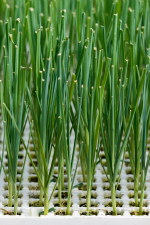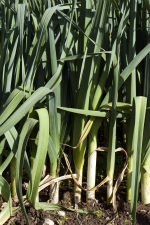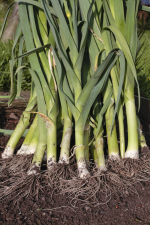Leek is a strange name for a vegetable but it really is an interesting one to grow. Leeks are related to onions but their flavour is more mild and much sweeter.
Leek are a cylindrical vegetable that grows straight up with a white stem that is between 3 to 6cm wide and then green, strappy leaves at the top. The white stem is the part that is eaten and when it is cut in half, it’s easy to see that it is made up of lots of layers
PLANTING
To plant seedlings in the ground, prepare the soil by removing any weeds and then dig lots of compost through the topsoil. Use a dibbler or a large stick to make small holes about 20cm apart and place one seedling in each one. Gently push the soil around the roots and water lightly.
Leeks can be grown in large pots that are at least 30cm deep but they need to still get 6 hours of direct sunlight. Fill the pot with premium potting mix before planting the seedlings and water the soil lightly.
Plant another crop of leeks in 6 weeks so that the family always has a good supply.
CARE AND MAINTENANCE
Leeks need to be watered regularly and do best when fertilised every two or three weeks as this encourages nice thick stems.
HARVESTING
Leeks can be harvested once their stems are at least 2cm thick which could take about 12 weeks. Only harvest the leeks that you need leaving the rest to continue to grow. The whole leek can be harvested and the roots cut off afterwards but sometimes, if the stem of the leek is cut off quite low and the root kept in the ground, small stems will reshoot from the side.
HOW TO EAT
Some care has to be used when preparing to cook a leek as sand and grit can get between the layers. To make sure that this is all washed away, cut off the base of the stem as well as the long green leaves leaving just the white stem. Then, use a knife to cut the stem length ways into two long halves. Wash these halves under a running tap to loosen the grit, checking that none is left between the layers.
Once the leek is cleaned, it can be sliced ready to be steamed, boiled or microwaved. It is absolutely delicious sauteed in butter or with some garlic and bacon and is a very popular addition to quiches. Try cooking Leek and Potato soup, delicious! Find this and other recipes in the Smarty Plants Kitchen.
HOW THEY GROW
Leek seedlings look like very thin grass. As they grow, their white stem thicken and their leaves become quite tough and usually fold over. They have very shallow roots that grow under the ground.
FAST FACTS
Botanical Name: Allium porrum
Life Cycle: Annual
When to Grow: Spring to autumn in cooler parts of Australia but late summer and autumn in warmer areas.
Height/Width: 40cm x 20cm.
Requirements: Plant in full sun and keep the soil moist. Fertilise fortnightly.
Nutritional Benefits: Good source of vitamin C but also contains smaller amounts of other vitamins and minerals.




